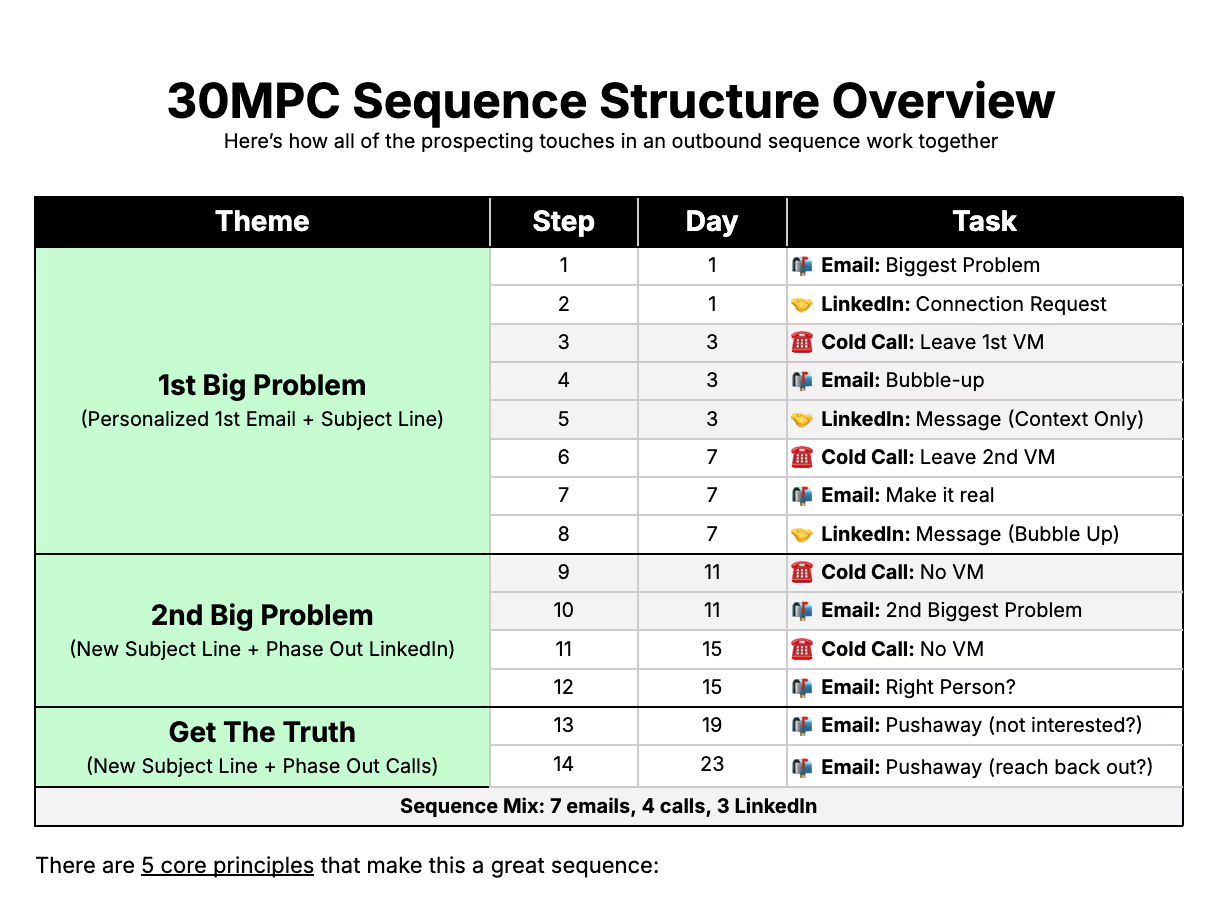You open a cold call. They let you proceed. It's time to "pitch."
For most sellers... this means spewing a 60-second feature and buzzword dump from their marketing team that sounds like a B2B sales reincarnation of a Billy Mayes infomercial.
Most "pitches" and "value propositions" absolutely suck.
- They usually contain buzzwords and marketing jargon like “single source of truth” or “all in one platform” that mean absolutely nothing to a prospects.
- They focus on features and benefits instead of pain (which is far more likely to compel action).
- Your product has no value unless it’s solving a problem. Nobody cares about your titanium-plated nonstick pan if they like their cookware. They will if you remind them that the egg stuck to their pan last week and ruined their day.
Still not sold? Gong data shows that problem language (16% success rate) is literally 3x more effective than buzzwords (5.5% success rate).
If you spend 80% of the time on the problem, you barely have to explain the solution.
So today, we're giving you a pitch replacement in 3 steps with The Problem Proposition:
- Triggering Problem: Describe the problem so specifically that it triggers the prospect by creating a visual of a crappy situation they’ve dealt with in the past
- One-Sentence Solution: Explain your biggest differentiator that allows you to solve the problem with “we do X so that the problem goes away”
- Interest Based Call to Action: See if they’re interested in taking a look rather than jumping to asking for the meeting
Let's break it down.
Step 1: Build a triggering problem
The biggest miss in building a triggering problem is most people aren’t specific enough. Saving time, making money, and mitigating risk aren’t specific enough. Your prospects have heard it from every other sales goon out there.
Let's start with a "base" problem, then notice how we get more specific by adding triggers:
.avif)
This might make you gag, but you want to aim for hairy lollipop-specificity.
Imagine you’re sucking on a lollipop. You drop it on a shag rug and pick it up.
What do you see?
HAIR!!!!!!!
Here's the final example we'll use throughout this newsletter, from my time at Pave:
Triggering Problem: During Q1 merit season, most Compensation teams are buried under a mountain of spreadsheets with 17,000 VLookups.
We'll continue building this example out. But first, two pro-tips.
Pro Tip A: 1 Big Problem or Use a 3-Part Problem
.avif)
You can vary your triggering problem based on whether your solution solves one massive pain point (like a point-solution) or a million little ones (like an ERP software).
See the examples above for two of my founder-led-sales advisory clients:
One Big Problem: Covey solves one massive problem: they use an AI bot to screen thousands of inbound resumes at once.
3-Part Problem: Practice helps tutoring businesses manage everything from the scheduling of tutoring sessions through the tutoring payouts (death by a million cuts)
Pro Tip B: "Chunk Up" For More Senior Personas
.avif)
Oftentimes getting too tactical on a problem can pull us into below-the-line language.
So in the Pave example above, we use a technique from Jason Bay called "Chunking Up" where we start with a process problem (comp planning in spreadsheets), then turn it into a bigger business impact (making equitable compensation decisions) that will resonate with those senior leaders.
Step 2: One-Sentence Solution
Because we’ve explained the problem in visceral detail, we only need to do two things to explain our solution in one sentence:
- Tell them that we solve the problem
- Give the minimum level of detail to make it believable
The magic formula is “we do X so that the problem goes away,” where X is your single biggest differentiator that allows you to solve the problem.
Here's an example of how the one-sentence solution attaches to the triggering problem:
Triggering Problem: During Q1 merit season, most Compensation teams are buried under a mountain of spreadsheets with 17,000 VLookups.
One Sentence Solution: Pave integrates your HRIS, equity, and comp data into one place so you never have to run merit cycles in spreadsheets again.
At Pave, compensation data usually lived in 10 different places, which meant you had to pull all of it into a spreadsheet to run a compensation review. So our key differentiator that allowed us to solve the problem was that we integrated with those solutions. That's it!
Step 3: Interest Based CTA
Most salespeople are trained to ask for the meeting. Our prospects are busy, so the meeting is a heavy ask because it forces them to make multiple decisions at once:
- Do I care about this problem?
- Do I believe they can solve it?
- Do I want to meet with this salesperson?
- Am I free during the times provided?
Instead, lock down their interest before locking down the meeting.
Use an interest based CTA like:
- I know I totally called you out of the blue, but would you be open to taking a look?
- Open to learning more, maybe when I'm not calling you out of the blue?
- I know this was outta the blue, but did any of that even moderately resonate?
You’ll notice three tricks that will make your ask sound less heavy:
- Use softening language like “Are you opposed to…” instead of heavy language like “Are you interested?” or “Let’s schedule a call.”
- Use no-based questions like “Are you opposed to..” because prospects tend to feel safer when saying no.
- Use mini push-away statements like “My guess is this came out of left field” to reduce the pressure of the sale
Starting with this small no-pressure ask increases your chances of an initial yes, at which point you can inch forward and go for the meeting.
Putting it all together, here's what it looks like fully baked out:
Triggering Problem: During Q1 merit season, most Compensation teams are buried under a mountain of spreadsheets with 17,000 VLookups.
One Sentence Solution: Pave integrates your HRIS, equity, and comp data into one place so you never have to run merit cycles in spreadsheets again.
Interest-Based CTA: I know I totally cold called you out of the blue, but would you be open to taking a look?
The Secret to Mastering Anything in Sales
.avif)
That's a wrap folks! There are three steps to mastering anything in sales:
- Learn it (via information)
- Do it (via accountability)
- Master it (via feedback)
Today you learned #1 for The Problem Proposition.
In our full Cold Calls to President's Club course, you get all 3 :)

















